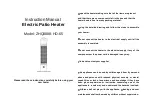
WARNING
The gas valve is a special gas valve which has a Pressure Augmented
Regulator feature, as well as
negative
outlet
pressure.
This valve must not be replaced with a conventional
valve under any
circumstances.
Make sure valve is in the “OFF”position prior to turning gas supply on.
As an additional safety feature, this valve has a left hand thread on the outlet end, and a special tamper resistant electrical connector.
VENTING
FOR ALL MODELS 3" VENT PIPE MATERIALS REQUIRED
For inlet air supply, top pipe on the right of the shroud, use 3" PVC schedule 40. It is very important that you plan the location properly,
to eliminate long pipe runs and excessive fittings. Inlet pipe size must not be reduced. Do not combine the inlet air with any other inlet
pipe including an inlet to an additional similar appliance. The joints must be properly cleaned, primed, and cemented. The piping must
also be properly supported as per local and national standard plumbing codes. It is important that the piping must be clean and free
from burrs, debris, ragged ends, and particles of PVC.
For exhaust piping, lower pipe on the right of the shroud, for the first 7’, use 3” ABS sch 40 or 3”CPVC sch 40 or 80. For concrete con-
struction or to meet certain fire codes, exhaust piping - lower pipe on right of shroud, and inlet air piping - top pipe on the right of the
shroud, must be 3" CPVC schedule 40 or 80, (only to meet local fire codes). The balance of the inlet and exhaust piping may be PVC
schedule 40 or 80, or ABS solid only,
NOT FOAM CORE
. For residential style wooden construction exhaust piping, lower pipe on right
of shroud, must be 3" ABS solid (NON FOAM CORE) or 3" CPVC schedule 40 or 80 for the first 7’ only. The balance of the inlet and
exhaust piping may be PVC or ABS solid NON FOAM CORE or CPVC to meet local codes.
The only approved exhaust vent materials are ABS solid NON FOAM CORE; first 84" or CPVC. The balance of the exhaust piping
must be ABS solid NON FOAM CORE, CPVC or PVC sch 40
NON FOAM CORE ONLY
. Exhaust piping should be sloped back to the
connection on the Voyager, at least 1/4" per foot to remove additional condensate that forms within the pipe. The total combined
length of pipe (intake piping plus exhaust piping added together) including elbow allowances intake and exhaust (each elbow = 5’ of
pipe) should not exceed 85’. The combined vent length should not be less than a combined length of 6’ plus two 90 degree elbows.
Choose your vent termination locations carefully; see
pages 22 and 23
. You must additionally make certain that exhaust gas does not
re-circulate back into the intake pipe. You must place them in a open area, and follow the following guidelines.
NOTE:
Per requirement of the ANSI Z21.10.3. 2004 1 CSA 4.3 -2004 a thorough review and compliance to Fig. 3-A pg. 21 in this
manual is required.
WARNING
1)
Never vent into a walkway or patio area, or an alley, or otherwise public area less than 7' from
the ground;
2)
Never vent over or under a window or over a doorway;
3)
Never install a heat saver or similar product to capture waste heat from exhaust;
4)
Always have vent location at least 1' above maximum snow level;
5)
Always have vent 1' above ground level, away from shrubs and bushes;
6)
Follow local gas codes in your region or refer to National Fuel Gas Code, or Can B149;
7)
Always have vent at least 3' from an inside corner of outside walls;
8)
Maintain clearance to electric, gas meters, and exhaust fans or inlets; (See Fig. 3A pg. 21 for
clearances)
9)
Very Important!
Inlet air must be taken from
outside
of building, next to exhaust outlet, no
closer than 8";
10) Always place screens in all openings
in intake and exhaust to prevent foreign matter from
entering the Voyager.
11)
The vent intake and exhaust must be properly cleaned and glued, for pressure tight joints. Several methods for venting the
Voyager can be found on
pages 22 and 23
. Use the following layout as a guideline; certain site conditions such as multiple
roof lines/pitches may require venting modifications-consult factory. The air inlet must be a minimum of 1’ vertically above the
maximum snow level or 24" which ever is greater. The air inlet must also be a minimum of 10’ horizontally from the roof, and
terminated with a tee. The exhaust must be a minimum of 24" above the air inlet opening, and terminated with a coupling. It
is very important that there are no other vents, chimneys or air inlets in any direction for at least 4’.
All venting must be prop-
erly supported, as the SUPER-E is not intended to support any venting whatsoever
. All piping, glue, solvents, cleaners,
fittings, and components, must conform to ASTM (American Society for Testing and Materials), and ANSI (American National
Standard Institute).
PAGE: 6
Summary of Contents for ANSI Z 21.10.3
Page 2: ...PAGE 2 ...
Page 12: ...PAGE 12 ...
Page 15: ...PAGE 15 ...
Page 16: ...PAGE 16 ...
Page 17: ...PAGE 17 ...
Page 18: ...PAGE 18 ...
Page 19: ...PAGE 19 ...
Page 21: ...PAGE 21 Figure 3 A Direct Vent Terminal Clearances per ANSI Z21 10 3 2004 CSA 4 3 2004 ...
Page 22: ...PAGE 22 ...
Page 23: ...PAGE 23 ...
Page 24: ...PAGE 24 ...
Page 25: ...PAGE 25 ...
Page 26: ...PAGE 26 ...
Page 30: ...PAGE 30 PARTS ILLUSTRATIONS ...
Page 40: ...PAGE 40 ...







































